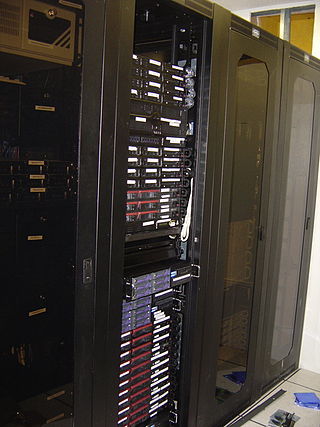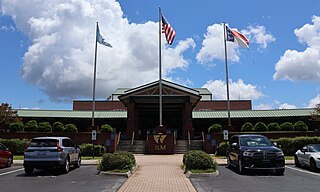
A render farm is a high-performance computer system, e.g. a computer cluster, built to render computer-generated imagery (CGI), typically for film and television visual effects.

VistaVision is a higher resolution, widescreen variant of the 35 mm motion picture film format that was created by engineers at Paramount Pictures in 1954.
Star Destroyers are capital ships in the fictional Star Wars universe. Star Destroyers were produced by Kuat Drive Yards, later Kuat-Entralla Engineering, and serve as "the signature vessel of the fleet" for the Galactic Empire, the First Order, and the Sith Eternal in numerous published works including film, television, novels, comics, and video games.
OpenEXR is a high-dynamic range, multi-channel raster file format, released as an open standard along with a set of software tools created by Industrial Light & Magic (ILM), under a free software license similar to the BSD license.
Industrial Light & Magic (ILM) is an American motion picture visual effects, computer animation and stereo conversion digital studio that was founded on May 26, 1975 by George Lucas. It is a division of the film production company Lucasfilm, which Lucas founded, and was created when he began production on the original Star Wars, now the fourth episode of the Skywalker Saga.

A server farm or server cluster is a collection of computer servers, usually maintained by an organization to supply server functionality far beyond the capability of a single machine. They often consist of thousands of computers which require a large amount of power to run and to keep cool. At the optimum performance level, a server farm has enormous financial and environmental costs. They often include backup servers that can take over the functions of primary servers that may fail. Server farms are typically collocated with the network switches and/or routers that enable communication between different parts of the cluster and the cluster's users. Server "farmers" typically mount computers, routers, power supplies and related electronics on 19-inch racks in a server room or data center.
Digital intermediate (DI) is a motion picture finishing process which classically involves digitizing a motion picture and manipulating the color and other image characteristics.
PHIGS is an application programming interface (API) standard for rendering 3D computer graphics, considered to be the 3D graphics standard for the 1980s through the early 1990s. Subsequently, a combination of features and power led to the rise of OpenGL, which became the most popular professional 3D API of the mid to late 1990s.

Star Wars: Bounty Hunter is a 2002 action-adventure video game developed and published by LucasArts for the GameCube and PlayStation 2. The PlayStation 2 version was later re-released as a PlayStation 2 Classics title on PlayStation 4 on January 15, 2016. This version was given a limited physical run published and distributed by Limited Run Games on June 28, 2019. An enhanced version developed and published by Aspyr was released for Nintendo Switch, PlayStation 4, PlayStation 5, Windows, Xbox One, and Xbox Series X/S on August 1, 2024.

Dennis Muren, A.S.C is an American film visual effects artist and supervisor. He has worked on the films of George Lucas, Steven Spielberg, and James Cameron, among others, and has won nine Oscars in total: eight for Best Visual Effects and a Technical Achievement Academy Award. The Visual Effects Society has called him "a perpetual student, teacher, innovator, and mentor."

Wilmington International Airport is a public airport located just north of Wilmington, North Carolina, in unincorporated Wrightsboro. ILM covers 1,800 acres.

Maxon ZBrush is a digital sculpting tool that combines 3D/2.5D modeling, texturing and painting. It uses a proprietary "pixol" technology which stores lighting, color, material, orientation and depth information for the points making up all objects on the screen. ZBrush shares some similarities with traditional sculpting.
Information Lifecycle Management (ILM) refers to a series of strategies in order to administrate storage systems on computing devices.

Nuke is a node-based digital compositing and visual effects application first developed by Digital Domain and used for television and film post-production. Nuke is available for Windows, macOS, and RHEL/CentOS. Foundry has further developed the software since Nuke was sold in 2007.
Death Star is a fictional giant military space station in the Star Wars universe, best known for its superweapon that can destroy planets.

Grant Masaru Imahara was an American electrical engineer, roboticist, and television host. He was best known for his work on the television series MythBusters, on which he designed, built and operated numerous robots and machines to test myths over the course of the show.

LuxCoreRender is a free and open-source physically based rendering software. It began as LuxRender in 2008 before changing its name to LuxCoreRender in 2017 as part of a project reboot. The LuxCoreRender software runs on Linux, Mac OS X, and Windows.
James Morris is an American film producer, production executive and visual effects producer. He is currently the general manager and president of Pixar. Previously, he held key positions at Industrial Light & Magic (ILM) for 17 years.

Robert Blalack was a Panama-born American mass-media visual artist, independent filmmaker, and producer. He is one of the founders of Industrial Light & Magic. Blalack received the Academy Award for Best Visual Effects in 1978 for his work on the first Star Wars film. He also received the Primetime Emmy Award for Outstanding Special Visual Effects in 1984 for his work on the 1983 television film The Day After. Blalack directed experimental films and mixed-media television commercials, and he produced visual effects for theme park rides.
StageCraft is an on-set virtual production visual effects technology composed of a video wall designed by Industrial Light & Magic (ILM) for the Disney+ series The Mandalorian. It has since been used in other productions and has been cited as a revolutionary visual effects technology. The soundstage in which StageCraft is implemented is called The Volume.









